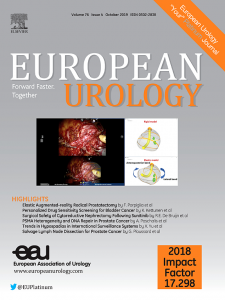Development and International Evaluation of an Artificial Intelligence–based Model (PROGRxN-BCa) Using the World Health Organization 2004/2022 Grading System to Predict Progression Risk and Improve Substratification for Non–muscle-invasive Bladder Cancer
IF 25.2
1区 医学
Q1 UROLOGY & NEPHROLOGY
引用次数: 0
Abstract
Background and objective
Current non–muscle-invasive bladder cancer (NMIBC) tools perform suboptimally in predicting progression risk to potentially lethal muscle-invasive disease. We aimed to improve risk assessment using artificial intelligence approaches (PROGression Risk assessment in NMIBC [PROGRxN-BCa]).Methods
PROGRxN-BCa was trained using 14 clinicopathological features on 3324 NMIBC patients treated from 2005 to 2022 at four Canadian institutions. External testing was performed on 9335 patients treated from 2005 to 2023 across 30 North American and European institutions. The primary outcome was time to progression (muscle-invasive or metastatic disease). PROGRxN-BCa was compared with the European Association of Urology (EAU) risk calculator. Performance was characterised using concordance index (c-index), calibration plots, instability assessments, decision curve analysis, and an algorithmic audit.Key findings and limitations
During a median follow-up of 3.3 yr (interquartile range 1.6–5.8), 1405 of 12659 patients progressed. In the external testing cohort, PROGRxN-BCa had significantly higher c-index (0.79, 95% confidence interval [CI] 0.77–0.80) and net benefit overall and across different subgroups compared with the EAU risk calculator (0.71, 95% CI 0.70–0.73, p < 0.001). This improvement was consistent regardless of treatment with bacillus Calmette-Guérin, adherence to guideline-concordant care, and World Health Organization 1973 or 2004/2022 grading system, and was consistent among patients with at least 5 yr of follow-up. It also outperformed other guideline-endorsed tools and a previously published artificial intelligence model. Compared with guideline recommendations, PROGRxN-BCa improved substratification of intermediate-risk patients into distinct risk tertiles, with estimated 5-yr progression risks of 2%, 7%, and 15%—the latter in line with high-risk NMIBC.Conclusions and clinical implications
PROGRxN-BCa outperformed current tools in the largest NMIBC cohort of its kind. Its integration into guidelines could improve risk stratification and patient management.基于人工智能的模型(PROGRxN-BCa)的开发和国际评估,该模型使用世界卫生组织2004/2022分级系统预测非肌肉浸润性膀胱癌的进展风险并改善下层分层
背景和目的目前的非肌肉浸润性膀胱癌(NMIBC)工具在预测潜在致死性肌肉浸润性疾病进展风险方面表现不佳。我们的目标是使用人工智能方法改进风险评估(NMIBC进展风险评估[PROGRxN-BCa])。方法采用14项临床病理特征对2005年至2022年在加拿大4家机构治疗的3324例NMIBC患者进行progrxn - bca训练。在2005年至2023年期间,来自30个北美和欧洲机构的9335名患者进行了外部测试。主要终点是进展时间(肌肉侵袭性或转移性疾病)。将PROGRxN-BCa与欧洲泌尿外科协会(EAU)风险计算器进行比较。使用一致性指数(c-index)、校准图、不稳定性评估、决策曲线分析和算法审计来表征性能。在中位随访3.3年(四分位数范围1.6-5.8)期间,12659例患者中有1405例出现进展。在外部测试队列中,与EAU风险计算器(0.71,95% CI 0.70-0.73, p < 0.001)相比,PROGRxN-BCa总体和不同亚组的c指数(0.79,95%置信区间[CI] 0.77-0.80)和净收益显著更高。这种改善是一致的,无论使用卡氏芽孢杆菌-谷氨酰胺治疗,遵守指南-一致性护理,以及世界卫生组织1973或2004/2022分级系统,并且在至少5年随访的患者中是一致的。它的表现也优于其他指南认可的工具和先前发表的人工智能模型。与指南建议相比,PROGRxN-BCa改善了中度风险患者的亚分层,使其分为不同的风险分类,估计5年进展风险为2%、7%和15%,后者与高危NMIBC一致。结论和临床意义progrxn - bca在同类最大的NMIBC队列中优于当前的工具。将其纳入指南可以改善风险分层和患者管理。
本文章由计算机程序翻译,如有差异,请以英文原文为准。
求助全文
约1分钟内获得全文
求助全文
来源期刊

European urology
医学-泌尿学与肾脏学
CiteScore
43.00
自引率
2.60%
发文量
1753
审稿时长
23 days
期刊介绍:
European Urology is a peer-reviewed journal that publishes original articles and reviews on a broad spectrum of urological issues. Covering topics such as oncology, impotence, infertility, pediatrics, lithiasis and endourology, the journal also highlights recent advances in techniques, instrumentation, surgery, and pediatric urology. This comprehensive approach provides readers with an in-depth guide to international developments in urology.
 求助内容:
求助内容: 应助结果提醒方式:
应助结果提醒方式:


